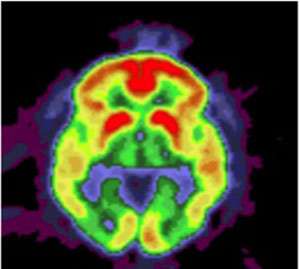Unlikely gene variants work together to raise Alzheimer's risk

(Medical Xpress)—Studying spinal fluid from people at risk for Alzheimer's disease, researchers at Washington University School of Medicine in St. Louis have found that a gene variation that had not been considered risky actually can increase the chances of developing Alzheimer's disease when it occurs in tandem with another gene variant known to elevate risk.
The findings are available online in the journal Public Library of Science (PLoS) Genetics.
"Up until now, variants in Alzheimer's genes have been classified only as pathogenic or nonpathogenic," said Carlos Cruchaga, PhD, the study's senior author. "Now we know that some of these variants, and particularly some combinations of variants, can be strong risk factors for the disease, but most researchers haven't focused much attention on them. We believe our findings may change that."
The investigators sequenced major Alzheimer's genes in four groups of people. The first group was made up of individuals with very high levels of the tau protein in their cerebrospinal fluid, a known risk factor for Alzheimer's disease. Tau is present in the tangles found in the brains of patients with the disorder.
Members of a second group had very low levels of the amyloid-beta protein in their spinal fluid, also a known risk for the disorder. Amyloid-beta aggregates into plaques that dot the brains of Alzheimer's patients.
The researchers also looked at people with very low levels of tau and very high levels of amyloid-beta. Those individuals would be presumed to be at very low risk for Alzheimer's disease.
"We used individuals with extreme levels of these proteins to identify known gene variants linked to Alzheimer's disease," Cruchaga said. "Then we analyzed the association of those variants with risk, and that's when we found gene variations that increase the risk of the disease when they appear alongside other risk variants."
By concentrating on people with very high or low levels of tau or amyloid-beta, Cruchaga's team more easily could locate potential risky gene variants using DNA from fewer subjects than would have been required if they had studied spinal fluid taken from unselected individuals.
Prior to this study, the researchers knew that the ApoE4 gene carried the largest known genetic risk for late-onset, sporadic Alzheimer's disease. Caucasians with two copies of that gene are 10—30 times more likely to develop Alzheimer's by age 75 than those who have ApoE3 or ApoE2 variants instead.
About 40 percent to 65 percent of Alzheimer's patients have at least one copy of ApoE4, but at least one-third of those who eventually develop Alzheimer's don't have the gene, and some people with two copies of ApoE4 never develop the disorder. The findings from this study may help explain why.
Cruchaga's team discovered that when people had one copy of ApoE4 as well as a particular variant in an Alzheimer's gene called PSEN1, their risk for Alzheimer's disease was similar to individuals who had two copies of ApoE4.
"The PSEN1 variant we identified in this study previously had been considered unlikely to contribute to the illness," said Cruchaga, an assistant professor of psychiatry. "But we found that this PSEN1 gene variant somehow cooperates with ApoE4 to increase risk."
Cruchaga and his colleagues began the study with DNA from 212 volunteers. They focused only on the six genes previously identified as risk factors for Alzheimer's disease: ApoE, amyloid precursor protein (APP), PS1, PS2, progranulin (GRN) and tau (MAPT). The investigators then identified all of the variants that occurred in each of those genes.
The findings help illustrate how a relatively small number of genetic variations may be able to cause so many cases of Alzheimer's disease.
"Current, large studies of Alzheimer's disease have identified a smaller number of genes than we would have expected," Cruchaga said. "So the question is where is the rest of the signal coming from? And this paper is a clear illustration that interaction between genes helps contribute to the risk for Alzheimer's disease."
More information: Benitez, B. et al. The PSEN1, p.E318G variant increases the risk of Alzheimer's disease in APOE-4 carriers, PLoS Genetics, vol. 9 (8), Aug. 2013.


















